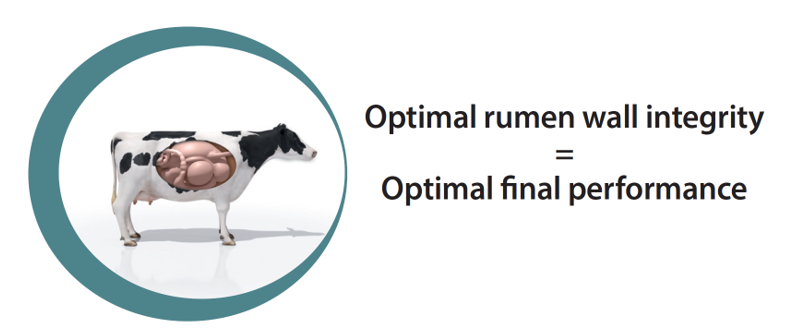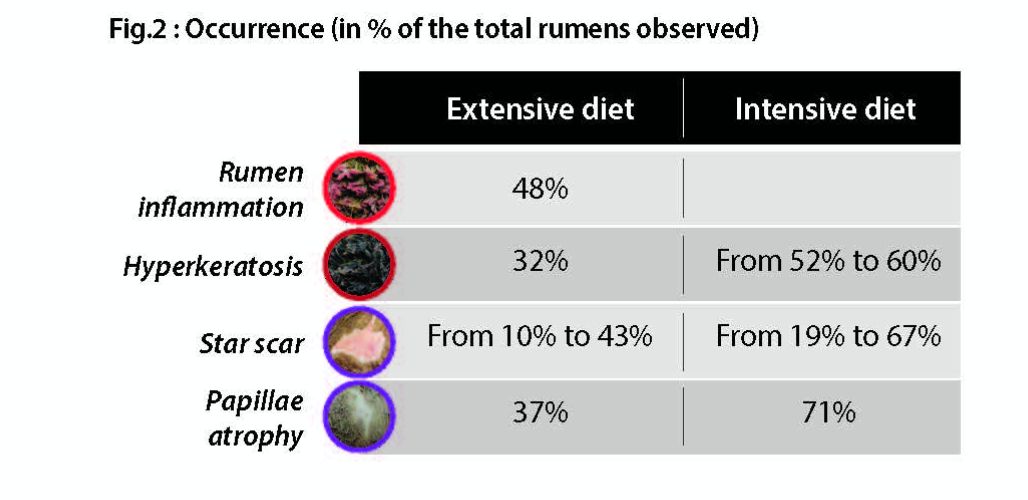



Could suboptimal cow performance be due to a damaged rumen wall?
The implications of a compromised rumen wall integrityRumen health is essential for an efficient, productive and healthy dairy herd. Ruminant technical expert, Emilie Arcier, from Lallemand Animal Nutrition, discusses the implications of compromised rumen wall integrity in both intensive and extensive systems throughout the lifecycle of the dairy cow.
“A healthy rumen is vital for the success of the dairy herd, playing a key role in nutrient digestion and absorption, yet a large proportion of cows experience a high degree of rumen wall damage,” says Emilie Arcier.
Recent research, carried out by Lallemand Animal Nutrition observing cattle at slaughter, has highlighted the extent of rumen wall damage, with more than 50% of animals in the study being affected to a lesser or greater extent.
An Australian study carried out in 2019 also found that cows with minimal rumen wall damage, produced 500kg of milk per year more than those with visible rumen defects.
Emilie Arcier explains that even in systems typically considered lower risk, such as extensive grazing, we still found rumen epithelium damage in more than half of the animals analysed post-slaughter. The lesions observed varied from rumen inflammation to parakeratosis and ulcers.
The findings suggest that wellbeing, efficiency and productivity of dairy herds could be improved by taking steps throughout the animal’s life to prioritise rumen health and protect the integrity of the rumen wall(Fig.1)

Why maintaining rumen wall integrity is crucial?
From weaning through to production, feed management and environmental factors can considerably impair the rumen balance and damage the rumen wall.
If not carefully managed this has the potential to significantly impair the animal's ability to extract nutrients from the diet.
Emilie Arcier says that the rumen's complex microbiota plays a pivotal role in breaking down dietary polysaccharides into volatile fatty acids (VFAs), essential for energy. 88% of the VFAs from the diet are absorbed via the rumen papillae, which is why rumen wall integrity is so important.
- In a recent study in France, Lallemand experts assessed 1,113 cattle rumens post-slaughter, comprising both dairy and beef cattle from mainly extensive grass-based systems.
The results found the prevalence of rumen acidosis, characterized by inflammation of the rumen lining, to be high and comparable to intensive systems.
- Another study carried out in Australia in 2019, with 562 dairy cows in an extensive grass system showed the impact of a comprised rumen wall on milk yield.
- The study looked at dairy cows post-slaughter and found that milk yield in cows with a damaged rumen wall was nearly 7% lower than in cows with a healthy rumen.
Cows with a healthy rumen had a total year lactation performance of +8.4T versus +7.9T milk/lactation for those showing signs of damage; this is equal to an additional 500kg of milk per year.
These studies tell us that rumen wall damage is more widespread than we may expect, even in grass-based diets, and this can significantly impact the cow’s ability to absorb energy through the rumen wall. (Fig.2)

The causes of rumen wall damage
Disruptions to the rumen, such as changes in rumen pH, caused by sudden dietary shifts (even turn out to grass is a risk), environmental stressors and physical illness, can lead to rumen wall damage.
This will affect the animal’s ability to absorb nutrients via the rumen wall, ultimately impacting growth and productivity, and potentially also health.
One of the biggest causes of rumen wall damage is Sub Acute Ruminal Acidosis (SARA).
SARA occurs when the cow’s rumen experiences extended periods of low pH, below 5.5-5.6.
This usually happens when cows' diets are quickly changed to contain high amounts of rapidly fermentable carbohydrates (VFAs) without adequate fiber, which may occur when introducing concentrates or when turning cow’s out to pasture, for example.
This causes a pH drop in the rumen which negatively affects the bacteria at a microbiota level, and damages both the epithelium and papillae.
All of this causes a ‘leaky’ rumen wall; the natural layers of the rumen wall are damaged, and it becomes thinner.
Compromised rumen barrier epithelium might also allow toxin translocation and bacteria migration into the bloodstream, promoting local inflammation in the feet or horns.
Supporting rumen wall integrity for optimised performance
Producers need to be mindful of supporting rumen wall integrity from the weaning stage to ensure optimal performance in the mature animal.
The rumen-specific live yeast Saccharomyces cerevisiae CNCM I-1077, commercially known as LEVUCELL SC, is scientifically proven to enhance rumen development and function.
LEVUCELL SC works by stabilizing pH levels in the rumen, reducing lactic acid buildup, and promoting beneficial microbial activity.
This helps promote rumen epithelium development and prevents any damage to the rumen wall, which could have long lasting impact throughout the animal's life. This is why the focus on rumen health needs to start in the young dairy heifer.
In the young ruminant, the focus should be on rumen papillae development, to increase absorption surface and integrity.
LEVUCELL SC is proven to promote rumen papillae development and increases absorption surface in the rumen by 14%. It also needs to be paired with an optimal diet.
During the growing stage, the priority is increasing rumen microbiota resilience to changes, for example, that may occur during transportation, heat stress, mixing of social groups, turnout to grass or dietary changes.
This will help minimize any damage to the rumen wall, which will affect the animal’s ability to absorb nutrients throughout its life.
LEVUCELL SC has a microbiota balancing effect, in addition to oxygen scavenging, which will protect the rumen during key risk periods, which will decrease rumen epithelium damages.
By investing in your herd through proper management and feeding a rumen-specific live yeast, producers can ensure optimal rumen health, wellbeing and ultimately productivity.



